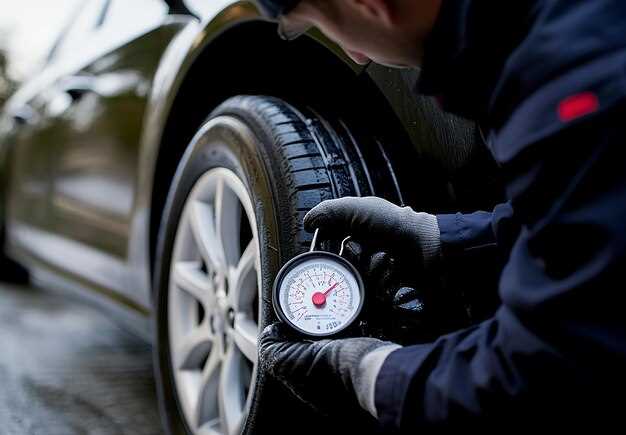

Proper tire maintenance is crucial for ensuring safety and performance while driving. One of the most important aspects of tire care is maintaining the correct tire pressure. Under-inflated or over-inflated tires can lead to poor handling, reduced fuel efficiency, and increased wear and tear, ultimately jeopardizing your safety on the road.
Throughout the year, temperature fluctuations can significantly affect tire pressure. As the temperature decreases, tire air pressure tends to drop, and conversely, it rises in warmer conditions. Therefore, being proactive in checking and adjusting your tire pressure becomes essential no matter the season. Regularly monitoring your tire pressure not only promotes optimal performance but also contributes to longer tire life.
Additionally, understanding the manufacturer’s recommended tire pressure for your vehicle is key. Always refer to the owner’s manual or the sticker located on the driver’s side door frame. By following these recommendations and incorporating routine checks into your driving habits, you can ensure that your tires remain in excellent condition all year round.
How to Check Tire Pressure Accurately
Maintaining proper tire pressure is essential for safe and efficient driving throughout the year. To check tire pressure accurately, follow these steps:
1. Get a Reliable Tire Pressure Gauge: Invest in a high-quality tire pressure gauge for precise readings. Digital gauges tend to provide more accurate results compared to manual ones. Ensure it is calibrated correctly before use.
2. Know the Recommended Pressure: Refer to your vehicle’s owner manual or the sticker located on the driver’s side doorjamb for the manufacturer’s recommended tire pressure. This value may vary for different tires and is crucial for optimal performance.
3. Check When Tires Are Cold: Tire pressure fluctuates with temperature, so always check your tires when they are cold. This means measuring the pressure before driving or at least three hours after driving. Seasonal changes can impact pressure, making this step especially important at the beginning of hot or cold weather.
4. Remove Valve Caps Properly: Unscrew the valve caps on each tire carefully to avoid any dirt or debris from entering the valve stem. Set the caps aside in a clean place to prevent loss.
5. Insert the Gauge Correctly: Press the tire pressure gauge onto the valve stem firmly and quickly to prevent air from escaping. A hissing sound indicates the gauge is not sealed properly–adjust and try again for an accurate reading.
6. Read the Pressure: Note the reading on the gauge. If using a digital gauge, it will display the pressure automatically. Ensure you have the value in the units that match your vehicle’s specifications (PSI is commonly used).
7. Inflate or Deflate as Necessary: If the tire pressure is below the recommended level, add air until it reaches the specified PSI. Conversely, if the pressure is too high, release some air until it is within the acceptable range.
8. Recheck After Adjustments: After inflating or deflating, check the tire pressure again to confirm it is at the correct level. This ensures your adjustments were effective.
9. Replace the Valve Caps: Once you have finished checking all tires, replace the valve caps securely to maintain the integrity of the valve system and protect against dirt.
By following these steps, you can ensure your tires are properly inflated, contributing to safer driving and improved fuel efficiency, regardless of the season.
Adjusting Tire Pressure for Seasonal Changes

Maintaining the correct tire pressure is crucial for safe driving, especially as seasons change. As temperatures fluctuate, the air inside your tires expands and contracts, affecting pressure levels. In colder months, tire pressure typically decreases, while warmer weather can cause it to rise. Regularly checking and adjusting your tire pressure ensures optimal performance and safety.
In fall and winter, as temperatures drop, you may notice a significant decrease in tire pressure. It’s recommended to check your tires at least once a month during these seasons. When the temperature falls by 10°F, tire pressure can drop by about 1 PSI. To counteract this, inflate your tires to the manufacturer’s recommended pressure, which is usually found on a sticker inside the driver’s door or in the owner’s manual.
Spring and summer months bring higher temperatures, which can lead to increased tire pressure. Overinflated tires can result in reduced traction, uneven wear, and potential blowouts. It’s essential to monitor tire pressure during this period as well. Before embarking on long drives in warmer weather, ensure your tires are not only adequately inflated but also in good condition. Maintaining proper pressure enhances fuel efficiency and extends tire life.
In summary, adjusting tire pressure according to seasonal changes is a vital aspect of tire care. Regular monitoring throughout the year ensures safe driving conditions and prolongs the lifespan of your tires, allowing you to drive with confidence regardless of the season.
Best Practices for Tire Maintenance and Care

Proper tire maintenance is essential for ensuring a safe and efficient driving experience. To maintain optimal performance, check tire pressure regularly, ideally once a month and before long trips. Correct inflation levels can vary based on the vehicle and load, so always refer to the manufacturer’s recommendations found in the owner’s manual or on the vehicle’s door jamb.
Additionally, inspect your tires for signs of wear and damage, such as cracks, bulges, or uneven tread wear. Regular visual inspections help identify potential issues before they become serious problems. When it comes to tread depth, use the penny test; if you can see the top of Lincoln’s head, it’s time to replace your tires.
Seasonal changes can affect tire performance significantly. Switching to winter tires in colder months enhances grip on icy roads, while summer tires excel in warmer conditions. Always store tires properly off-season, keeping them in a cool, dry place to prevent deterioration.
Don’t overlook the importance of rotating tires regularly to ensure even wear. Most experts recommend rotating tires every 5,000 to 7,500 miles, depending on driving habits and vehicle type. When you do rotate, also align and balance your tires to promote longevity and improve driving stability.
Finally, practice cautious driving to extend the life of your tires. Avoid sudden braking and sharp turns, as these actions can lead to unnecessary wear. By following these best practices, you can ensure that your tires remain in good condition year-round, enhancing safety and performance on the road.







